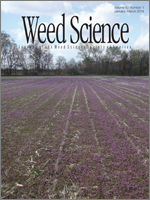Winter annual weeds are becoming prolific in agricultural fields in the midwestern United States. The objectives of this research were to understand the roles of soil temperature (daily average and fluctuation) and moisture on the emergence of nine winter annual weed species and dandelion and to develop predictive models for weed emergence based on the accumulation of modified thermal/hydrothermal time (mHTT). Experiments were established at Lincoln, NE; Mead, NE; and at two sites (irrigated and rainfed) near Clay Center, NE, in 2010 and 2011. In July of each year, 1,000 seeds of each species were planted in 15 by 20 by 6-cm mesh baskets installed between soybean rows. Soil temperature and water content were recorded at the 2-cm depth. Emerged seedlings were counted and removed from the baskets on a weekly basis until no additional emergence was observed in the fall, resumed in late winter, and continued until emergence ceased in late spring. Weather data were used to accumulate mHTT beginning on August 1. A Weibull function was selected to fit cumulative emergence (%) on cumulative mHTT (seven base temperature [Tbase] by six base water potential [Ψbase] by three base temperature fluctuation [Fbase] candidate threshold values = 126 models); it was also fit to days after August 1 (DAA1), for a total of 127 candidate models per species. The search for optimal base thresholds was based on the theoretic-model comparison approach (Akaike information criterion [AIC]). All three components (Tbase, Ψbase, and Fbase) were only important for Virginia pepperweed. For downy brome and purslane speedwell, including Tbase and Ψbase resulted in the best fit, whereas for dandelion including Tbase and Fbase resulted in the best fit. A model including only Tbase resulted in the best fit for most species included in this study (Carolina foxtail, shepherd's-purse, pinnate tansymustard, henbit, and field pansy). For field pennycress, the model based on DAA1 resulted in the best fit. Threshold values were species specific. Soil temperature was the major environmental factor influencing winter annual weed emergence. Even though soil moisture and often temperature fluctuation are essential for seed germination, Ψbase and Fbase were not as critical in the predictive models as initially expected. Most seedlings (> 90%) of downy brome, pinnate tansymustard, Carolina foxtail, henbit, and field pansy emerged during the fall. Virginia pepperweed, purslane speedwell, dandelion, shepherd's-purse, and field pennycress seedlings emerged during both fall and spring. The results of this research provide robust information on the prediction of the time of winter annual weed emergence, which can help growers make better management decisions.
Nomenclature: Carolina foxtail, Alopecurus carolinianus Walt. ALOCA; dandelion, Taraxacum officinale G.H. Weber ex Wiggers TAROF; downy brome, Bromus tectorum L. BROTE; field pansy, Viola bicolor Pursh VIORA; field pennycress, Thlaspi arvense L. THLAR; henbit, Lamium amplexicaule L. LAMAM; pinnate tansymustard, Descurainia pinnata (Walt.) Britt. DESPI; purslane speedwell, Veronica peregrina L. VERPG; shepherd's-purse, Capsella bursa-pastoris (L.) Medik. CAPBP; Virginia pepperweed, Lepidium virginicum L. LEPVI; Glycine max (L.) Merr.





